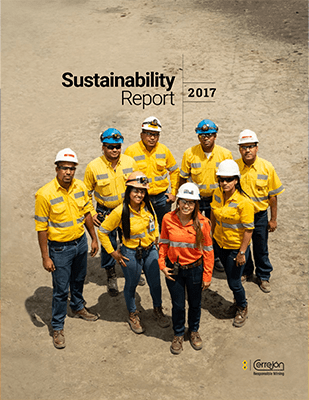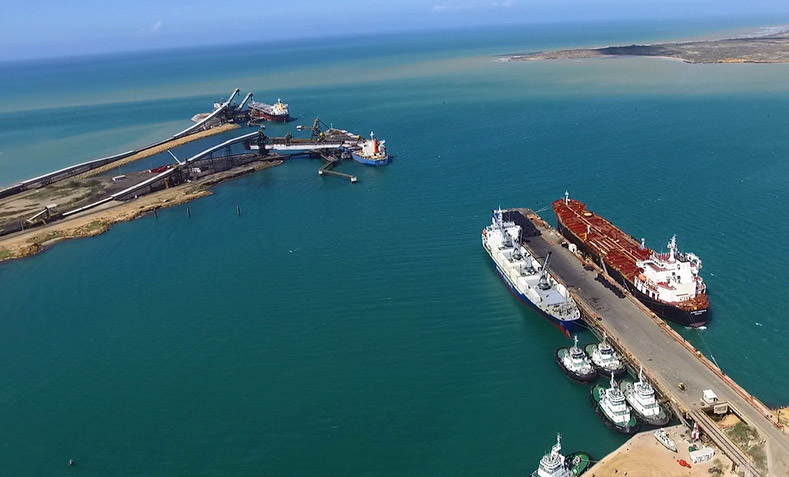E-Newsletter 2018

Guillermo Fonseca takes over as Cerrejón president
Guillermo Fonseca, who took over as President of Cerrejón on October 29, 2018, is an Economist who studied at the Universidad de Los Andes with complementary studies in Management and Leadership. Fonseca has more than 30 years of experience in the hydrocarbon industry, having worked at companies such as Shell, BP and Talisman in Colombia, England, Argentina and the United States.
In his professional career, Fonseca has worked for more than 15 years in the BP group of companies, leading downstreaming strategy for nine global businesses, lubricants for Latin America, and at various times working as an E&P Financial Business Manager in North America, Argentina and Colombia. Since 2013, he served as President of Hocol, a hydrocarbon exploration and production subsidiary of Ecopetrol.
Fonseca has commented that he is “very excited to come to one of the most exemplary and interesting companies in the country. I take on this new challenge with a huge commitment to continue working to keep Cerrejón one of the most competitive global mining companies under the highest precepts of care for the environment and respect for the communities and for the workers, values that are both personally and professionally fundamental for me”.
Cerrejón publishes its sustainability report 2017: A Commitment to sustainable development goals

As part of our ongoing commitment to transparency and accountability, Cerrejón presents for its stakeholders the new Sustainability Report 2017, created under standards from the Global Reporting Initiative and verified by an independent third party. We encourage you to consult our report here.
This report began with a materiality analysis, which has allowed us to identify relevant issues in the operation and those that create value for our interest groups in the short, medium and long term. The most relevant aspects were prioritised in two dialogue sessions held in La Guajira and Bogotá with 81 representatives from indigenous communities, employees, suppliers, the media, authorities, academia, government, journalists and NGOs. In addition, we did 155 virtual surveys that, added to the previous, allowed us to select the issues of most importance.
The 2017 report shows the results of our performance in areas such as ethics and governance, relationships with interest groups, management of social and environmental impacts, social intervention strategy, resettlements and mine closure, among others. In this version, an alignment of our operation with the Sustainable Development Goals (SDG) is presented, in particular with the five goals that have been prioritised in Mapping Mining to the Sustainable Development Goals proposed by the United Nations Development Programme, the World Economic Forum, the Columbia Center on Sustainable Investments and the Sustainable Development Solutions Network:
SDG 6: Clean Water and Sanitation
SDG 7: Affordable and Clean Energy
SDG 8: Decent Work and Economic Growth
SDG 9: Industry, Innovation and Infrastructure
SDG 15: Life On Land
This process has allowed us to have a greater approximation on how we can contribute as a company and industry to fulfilling the agenda and goals outlined for 2030 and as such contribute to the worldwide call to end poverty, protect the planet and guarantee that everyone enjoys a better quality of life.
Cerrejón audited by bettercoal

As part of Cerrejón’s commitment to being a responsible company, committed to properly managing its impacts, to adopting recognized standards for social and environmental performance, the preservation and restoration of the environment, the wellbeing of our neighboring communities and employees and to being a profitable and trustworthy coal supplier, in July 2018 the company was audited by the Bettercoal organization.
This is an initiative that brings together 17 energy companies and 18 coal suppliers from Africa, America, Asia and Europe who are interested in promoting continuous improvement in their coal supply chain in matters of ethics and corporate governance, enforcing human rights, relationships with communities and management of environmental impacts in accordance with the Bettercoal code.
The evaluation encompassed a review of Cerrejón’s policies, procedures and management systems and a social and environmental performance analysis that included issues such as: quality management of air and water, land conservation and biodiversity, waste management, regulatory implementation and fulfilment, transparency and commitment to human rights and community development.
On this occasion, the Bettercoal auditors had an opportunity to dialogue with a group of five NGOs, academic institutions and think tanks, the company’s two unions, representatives from 15 communities living near the operation and eight governmental institutions, both regional and national. Furthermore, 59 surveys were done with company workers and contractors.
Results from the Bettercoal audit have provided us with a series of tasks that will be laid out in the creation of a Continual Improvement Plan. Fulfilment of this Plan will be tracked by means of documented proof and mine visits made by Bettercoal. Additionally, Bettercoal will share a public report on its website noting advances and results from this Plan. As such, we are sure that as the gaps found in the audit are closed, value-added will be created in our operation which will have an effect on the neighbouring communities, the region, contractors and employees.
Tamaquito II: A brief overview on how access to water works
Five years have gone by since the Wayuu community of Tamaquito II was resettled on the plot of land known as La Liga. This process began in 2006 and has been a mutual learning experience as well as a lesson in overcoming important challenges.
One of these challenges has been access to water both for human consumption and use with agricultural projects. After various difficulties including a long period of drought suffered in La Guajira in 2014 and 2015, delays in the delivery of certain results on the part of the company, obtaining permits and licenses, and normal processes having to do with internal reflection by the community, today it can be confirmed that Tamaquito II has sufficient water for human consumption as well as enough for use on their crops and for their animals.
Although Tamaquito II had access to water from three different underground sources from the moment they moved to the new settlement in 2013, ensuring the desired quality and quantity was not without its challenges. It was necessary to replace the first underground water treatment plant, as high maintenance costs made its upkeep unviable. This knowledge led us to search for a plant that was of high quality and made locally, easier to maintain and with lower costs. This new plant began its assembly and stabilization process in May 2017, and was inaugurated in June of this same year.
Aware of the importance of strengthening Tamaquito II and making sure they had the abilities to adequately use the plant, the company and the community worked on creating a community organization, Tamawuin, a company dedicated to ensuring the proper functioning and maintenance of the plant in accordance with existing regulations on the provision of treated water. Thus, Cerrejón is responsible for providing the necessary resources to keep the plant functioning, which includes payment and technical training of staff from Tamawuin and the supplies to ensure it performs well. Tamawuin, for its part, must be sure to continually provide the water services and efficiently utilize the resources that Cerrejón provides to carry out this work.
Following training and support done with the Tamawuin community organization, very satisfactory results have been achieved in regard to water quality, obtaining a level 0 on the Water Quality Risk Index (IRCA, its acronym in Spanish), which measures potability (water potability is obtained at indexes between 0 and 5, with 0 being the best).
According to reports from Tamawuin, the treatment plant delivers an average of 19.6 cubic meters of water per year to each of the 31 families in Tamaquito II. This represents 100% coverage of the community, which has a population of approximately 200 people.
Regarding access to water for agricultural uses, a reservoir has been constructed with a capacity of 1.155 cubic meters of water. Water pipes have also been built to be used exclusively for agricultural uses by the community, with this irrigation outlet providing water for crops such as corn, yucca, sorghum, pasture grass, melons, peppers, squash and tomatoes. These crops represent a total of 23 hectares. Meanwhile, 100 chickens and 2,000 goats also benefit from this system. The amount of water allocated to these crops is 930 cubic meters although, to date, the community has not used this amount.
With the use of direct and respectful relationships, personified in the Cooperation Agreement signed between Cerrejón and Tamawiun in June 2018, we have worked hand in hand to create opportunities for this community, an example of empowerment, ownership and the collective construction of a better future.
Ten years of the international review panel on Cerrejon´s social practices
Ten years ago Cerrejón and its shareholders, with the goal of improving management of the impacts caused by the operation and to make a larger contribution to improving life conditions in the territory and communities in its area of influence, convened an independent review panel made up of Dr. John Harker, President of Cape Breton University in Canada; Salomón Kalmanovitz, Dean of Economics and Business Administration at Jorge Tadeo Lozano University in Colombia; Nick Killick of the NGO International Alert; and Elena Serrano of the Chilean NGO Casa de la Paz. The panel made an evaluation of Cerrejón’s social engagement (current and past) and recommended alignment with standards in the management of negative impacts as well as suggestions on how to have more and better positive impacts.
From the panel’s recommendations, we have worked to resolve liabilities, to strengthen the implementation of recognized international standards in social management and respect for human rights, and to increase the effects of our social investment. All this has been done with an open, transparent and participatory attitude. Of the 24 specific commitments that we agreed to move forward on, we have fulfilled 22 and continue working on the other two. Many programs were resolved quickly, but others have been complex to achieve, and we have learned as much from the failures as we have from the successes.
Among specific achievements we can point to the implementation of a committed organizational culture that applies international standards for responsible management of the impacts caused by the operation; the transfer of 100% of the families eligible for resettlement in accordance with standards defined by the International Finance Corporation (IFC); and the completion of numerous projects developed through the different Cerrejón Foundations to improve access to water for the indigenous communities, to strengthen institutions and the community as well as indigenous culture, and to develop effective projects for the region. Since 2010 we have had 24 roundtable talks on subjects having to do with security. These roundtables seek to reach consensus with the communities on proper management of security agreements with law enforcement authorities and with the private security firms hired. We have also actively promoted better practices and the sharing of experiences with companies and industry associations.
Nonetheless, in this process it has not been possible to achieve everything we hoped for. We have two important commitments pending: First, construction is pending on the community center for the community of Tabaco, which is to be built on the plot chosen by the community and donated by Cerrejón to the Hatonuevo Municipality. Also pending is compliance work to be carried out on roads and network systems. We share the community’s frustration in delays from the Municipality in meeting their obligations to construct new Tabaco and regret a fragmentation of the community that has lasted more than 15 years. We believe construction of the community centre will contribute to uniting the community, and we hope an internal agreement is reached quickly that authorizes us to begin construction. We actively participate in roundtables for follow-up and control of the relocation, and we support the community and the Municipality with the necessary management to achieve the goal of reconstruction in accordance with the desires of the community.
Second, in spite of having completed resettlement of all the eligible families in the new towns, it is still necessary to keep working on programs to ensure that all these people enjoy dignified life conditions. Specifically, although some productive projects have been successful, others need to be redefined or replaced with other types of jobs to assure the families’ economic sustainability over the long term. Access to water will continue to be a complex challenge in a territory such as La Guajira, although today we can say that all the resettlements have access to quality water for human consumption and agricultural projects.
Although there are new scenarios and situations, the challenges in La Guajira remain. Structural and institutional difficulties make the situation more complex, and many of the realities described by the panel continue. Following the spirit of the panel, we keep alive and unwavering the will to operate in a responsible, respectful and transparent way in the search for greater well-being for the communities.
Applying the principle of transparency, all the projects along with the quarterly reports on advances made have been published on Cerrejón’s website.

E-Newsletter 2018
